-
Paper Information
- Previous Paper
- Paper Submission
-
Journal Information
- About This Journal
- Editorial Board
- Current Issue
- Archive
- Author Guidelines
- Contact Us
Architecture Research
p-ISSN: 2168-507X e-ISSN: 2168-5088
2017; 7(3): 92-107
doi:10.5923/j.arch.20170703.04

Creativity in Store Design - A Study on the Influential Role of Store Design and Storefront Design in a Relationship with Urban Perception to Present a Brand
Ali M. Khalili
School of Architecture and Built Environment, Faculty of Engineering and Built Environment, The University of Newcastle, Australia
Correspondence to: Ali M. Khalili, School of Architecture and Built Environment, Faculty of Engineering and Built Environment, The University of Newcastle, Australia.
| Email: |  |
Copyright © 2017 Scientific & Academic Publishing. All Rights Reserved.
This work is licensed under the Creative Commons Attribution International License (CC BY).
http://creativecommons.org/licenses/by/4.0/

This study analyzes the creativity affecting the developments of store design and storefront designs in relation to the urban scape. Also, it will explore the understanding about how designs relate to inferences on store characteristics. Different approaches are applied in retail design and the ideas behind them have developed over time. By planning the main features and limitations of the development as it is at this point in time. For instance, the expected conditions from business owners can be developed, describing the outlines for an application in architectural and interior design. In this way, future perspectives should also be taken into developments account. The analysis of the state of Architectural/interior theories in store design and their expected functions for the business in the building can be combined with the description of a path for further research and strategies with a method to carry out in this paper. I address the purpose of this research through the analysis of the Prada epicenter in New York USA. This case study is considered to explicate the influential role of store front design on shop interior planning, and how the design influences customer perception.
Keywords: Creativity, Store design, Store front, Theory of the Design, Store environment
Cite this paper: Ali M. Khalili, Creativity in Store Design - A Study on the Influential Role of Store Design and Storefront Design in a Relationship with Urban Perception to Present a Brand, Architecture Research, Vol. 7 No. 3, 2017, pp. 92-107. doi: 10.5923/j.arch.20170703.04.
Article Outline
1. Introduction
- From the beginning it is good to know that Store and market designs do not only involve the foundation of the building form, but also everything that can be seen or touched in the store. On the other hand, literature suggests that, the outward of retail environments, more especially, storefronts have a distinctive effect on evaluations of store environments and evaluations for displayed products in store spaces. The customer's behavior and expectation within the store begins when they see the shop front, which could be an analysis designer to know to what extent she/he was successful to represent the branding. According to (Underhill, P 2009) many researches have been carried out on customer's interaction and on the creativity of the designer to the design a proper store environment. This creativity could be based on the distinctive business of the window front, planning, the colors and the lighting. This paper also illustrates what is important in store front design in the role of business identification to introduce the particular environment of a store like fashion and how this environment influences the customers through a shopping trip experience. This is the point that this study aims to challenge, how the store front design makes direct connection with the brand as well. Obviously, different brands have different impacts on the business sector. For example, some people would prefer a specified brand related to a life style, where designers are always expected to play distinguished roles in their approach design planning an attraction them and relevant window as a store front. This window should have the capability to engage with people.It’s clear that customers who are looking for high levels of goods will be attracted to stores that have created a specified background for their merchandise and have a special store front design, interior design, quality. Therefore, competitive design for flagships and businesses are present on the market because this is considered as important for business owners to be able to keep a proper environmental design. There is also another aim of this study. It will consider how designers deal with it, and where it is necessary to satisfy customer’s expectation by having an experience that meet their needs better than other direct competition. In fact, a successful business in a store environment is launched when the architect makes good connection with the required needs.This review is followed by a discussion of the relationships between the store design and creativity, which could lead to inviting the customer for a shopping experience. The methodology of the study is followed by the presentation of a case study as related by Rem Koolhaas to analyze that how the creativity of store design and storefront design in a relationship with urban perception can promote a brand. Finally this study presents the conclusions and implications, along with recommendations for future studies.
2. Store Design and Creativity
- According to (Jinfeng, W & Zhilong, T 2009) retail stores with different background carry different schemas in the market place, and a schema as a window is influenced by the divers elements of the shop marketing integration. In this way, development and creativity in the store designs associated with cultural activities are very depended on historical reasons such as local social, economic and technical factors specific to the periods. Everything that customers see and experience is linked together and forms their overall perception of a store. Storefront is the key player in the communication between customers and store. According to (Green, W.R. 1986), storefront acts like the front page of a newspaper; some readers will be attracted to the clean, restrained, uncluttered appearance while others will prefer a more sensational look and each is designed to reach a certain segment of the buying population. According to (Cornelius, B, Natter, M & Faure, C 2010) Store front turns to the path in which a shop is perceived by customers, and examined by them which is the best testimonial. Ellen Lutpon expresses that, “To me, a clothing store is a more accessible kind of gallery, a place where I can walk away with some art in my shopping bag.” (Moreno, S 2006). From her point of view buying experience is stimulated by the wonderful, unique and sophisticated atmosphere composed of the special fine architectural and interior design of a store, which surrounds customers while they browse in the special theme that shops offer. This is the opportunity for the brand owner to collect his/her benefits. The special customer service offered by those brands to their customers is an extra bonus in stimulating the customers. That will make them exited and interested in the offered merchandise because the creativity of the architect promoted the situation.
3. Rem Koolhaas and Prada
- Over the past years, retail design has been subject to an exhibitive and continuous transformation, one which is comprehensible in the emergence of large-scale out-of-town shopping complexes and new specialized shops in city centers.Store designs play a significant role in the samples of changing use and meaning in cities. Often designed as proposals in existing buildings like Prada epicenter and the former industrial building in Soho New York, their designers are able to use flexibly to larger developments on a global scale, following both fashions and trends to establishing them. The store design discipline has a high level of knowledge of developments in the wider cultural area, including the visual arts, visual culture and media.From the beginning, I would like to mention that previously how much the Prada stores have been similar in design. Presumably, this can lead us to an intelligible brief of what Mr Koolhaas purposed to create a distinctive epicenter of Prada in New York. It goes without saying that a brand needs developing to reach success which requires a stable flow of creative ideas, but also a specified unity and stability.Nowadays, it is difficult to think about influence and inspiration without considering some of the world’s leading global practices. There is an example of how Rem Koolhaas architect/town planner dealt with the project of Prada store in New York. Before finding the solution for the conceptual designs it is necessary to mention that Koolhaas tried to discover the right concepts to actually respond to designs issue. Initially, the intriguing factors that Rem Koolhaas/OMA has to deal with most of the time are capturing some sort of invention or discovery. Over time, Koolhaas tries to elaborate these findings. Not in every case, and not on every occasion, but only when he acquires a progress by bringing relevant opinions to the next level. For example, in New York, Koolhaas designed what he thought of as a representation of the easy, approachable character of the city, as the curve in the floor either functions as a texture for mannequins, cloths and shoes during the day or as a podium for fashion shows at night (Figure 1).
 | Figure 1. Prada store designed by Rem Koolhaas, Soho, New York (Huppatz, D.J, 2009) |
 | Figure 2. Miuccia Prada (Time, 2007) |
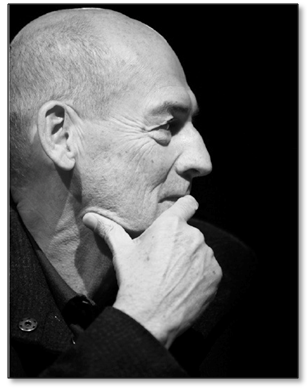 | Figure 3. Rem Koolhaas (Derotterdam) |
4. The Theory of the Design
- There are two contradictory understandings of Theory. On the one hand, theory hopes to be an authorizing practice deriving from a globally appropriate system of concepts. On the other hand, theory works as set of methods, strategies and styles of reading and thinking that work to interrupt that system. What Koolhass did about Prada store in Soho in New York has shown that how much he tracked the first understanding. Before a comprehensive discussion, Koolhaas was deeply influenced by Le Corbusier concept of modernism through his practice.The foundation and base of the theory not just behind Prada store project in Soho, New York but similar to other works of Koolhaas has inspired the Koolhaas view, which seems has an image of a surreal play of tensions between the universe of signs and the domain of the real. In contrast to Koolhaas with other architects in the world who preparing to dismiss the modern movement as an underplot to translocate everything with glass boxes, he has reinterpreted modern New York from a contemporary spirit of view, and Prada store in New York could be an obvious example of him in early 21st century.
5. Prada New York, USA
- The site of former Guggenheim Museum is the location on Broadway at Prince Street in the heart of Soho as one of the most famous neighborhoods of New York City where Rem Koolhaas designed shrine of Italian fashion (Figure 5, 6 &7). The Prada Epicenter was opened in 2001 with the subject of much media hype, and has heaped a wealth of architectural criticism since then. In this paper, rather than reviewing the comprehensive literature dedicated to the New York Prada, I will place the store within my initial framework to understand the current century interior. That is, while Prada is customarily realized (in architectural critique) as a sophisticated high-tech architectural container, how might we realize it as an interior? This needs thinking about how it is resided, how it is mediated, and its relationship with the formation of identity. The Prada store in downtown Manhattan is perhaps the most dramatic territory to document the changes in the city," Koolhaas says. "Ten years ago, this entire domain was a cultural domain or an industrial domain, and now virtually every ground floor is commercial space." Capitalizing on the insight that people spend more money in spaces that are not seen as purely commercial, Koolhaas has designed the Prada store in New York to be adaptable to cultural performances (LUBOW, A 2012).The significant issue was that how they could reformulate the space where people shop and also the way in of shopping in the space. In this case one question remains open, and it is that how they can theorize the relationship between consumption and architecture at the end of postmodernism. Since the early current century, consumption encircles an expansive collection of practices. Everyday people consume money, nature, ideas, environment, architecture, and at the same time they consume an experience. As time went on, the design of new spaces, effects and experiences have started to make clear the extent to which consumption has been complexly integrated into the shaping of contemporary architecture. As it is obvious, consumption has intertwined with architecture.
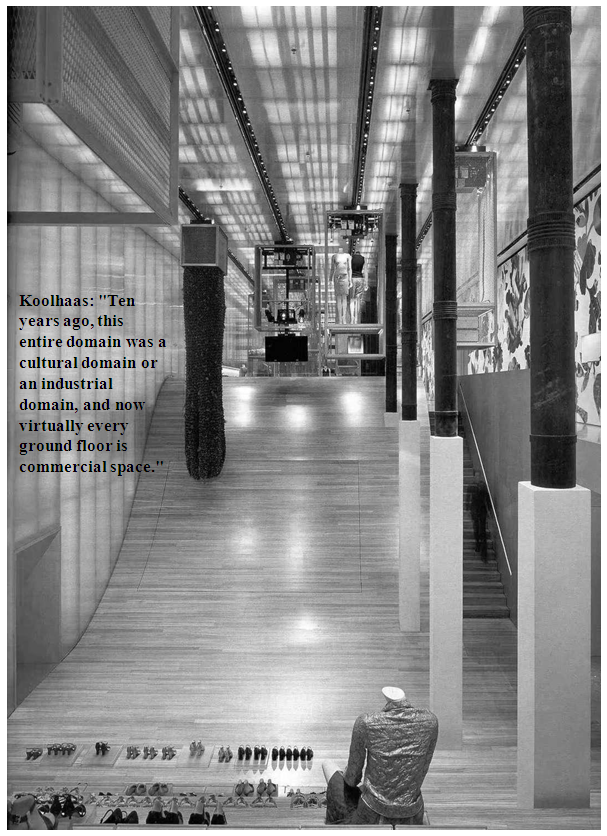 | Figure 4. Prada store designed by Rem Koolhaas, Soho, New York (Huppatz, D.J, 2009) |
 | Figure 5. New York’s Prada Epicenter location (OMA) |
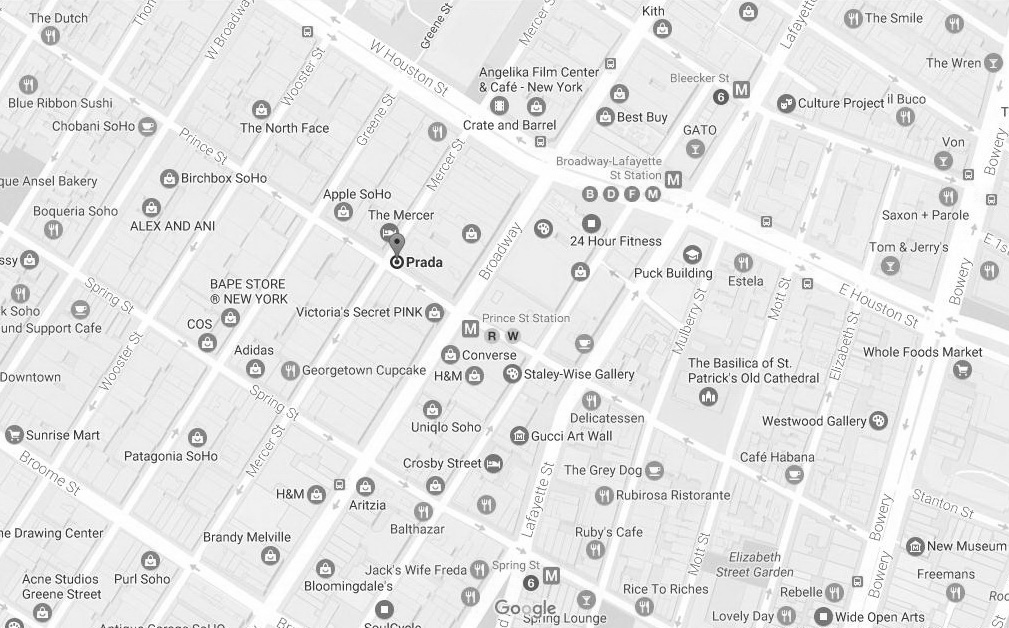 | Figure 6. New York’s Prada Epicenter location (Google) |
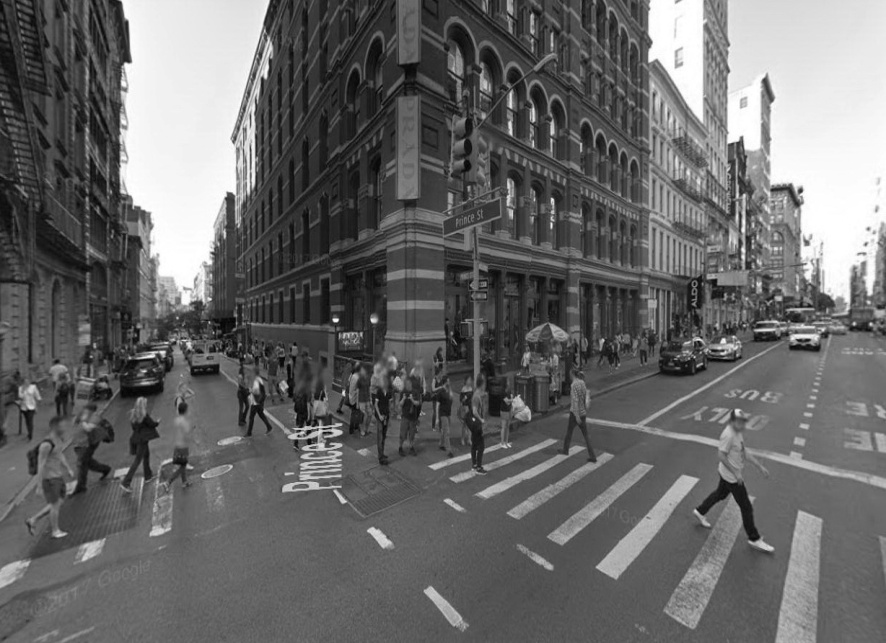 | Figure 7. New York’s Prada Epicenter, Streetscape (Google) |
6. How the Concept is Transferred to Design Brief
- Before setting to the design theory behind the Prada store in New York, there is a point that presumably could be a formula coming from the Manhattan theory. “If Manhattan is still in search of a theory, then this theory, once identified, should yield a formula for an architecture that is at once ambitious and popular. Manhattan has generated a shameless architecture that has been loved in direct proportion to its defiant lack of self-hatred, respected exactly to the degree that it went too far. Manhattan has consistently inspired in its beholders ecstasy about architecture” (Koolhaas, R 1978).According to (Huppatz, D.J, 2009), Koolhaas/ OMA’ team stated that “everything is shopping” in contemporary consumer culture. There is a point made in the Harvard Guide to Shopping: Hiromi Hosoya and Markus Schaefer’s essay “Brand Zone” noted “in the flagship stores in the brand zones of the global cities experiences must be provided, images sustained, myths created. Movement, symbols, sound, and smell all reinforce the stores’ message, which finds its ultimate embodiment in the figure of the designers after whom they are usually named. Increasingly, shopping’s obsession with the individual’s behavior and perception turns these spaces into engineered synesthetic environments” (Koolhaas et al. 2001). Therefore, with attention to the rational research in place, modernist architects like Koolhaas could take on shopping safely.With regard to what Hiromi Hosoya and Markus Schaefer stated in their assay, Koolhaas’s design of the New York Epicenter clearly not just reinterpreted shopping in contemporary consumer culture but it caused the store to turn out to be a city meeting spot to serve as the space for exhibitions, fashion events and parties. The Prada store is ambiguously positioned as a species of privately created public space.With the supportive theoretical background of Koolhaas “Manhattanism” and following the concept that Koolhaas/OMA stated in “Harvard Guide to Shopping”, we can derive that the theory responded to the design as ephemeral, iconic framework into which changing component sectors could refresh the space. Technically, the store is designed as “experiential space” for staging identity in which customers could become part of the complete, advertising campaigns, graphic styles and the store itself. In fact the concept has made the Prada’s self-conscious cultural elitism as an avant-garde design and architecture). The concept had them to derive to an incorporation of Prada’s values – progressive brand with the avant-garde art and architecture which made the design as a particular cosmopolitan class in the cultural capital.The association between Italian brand and Dutch architect has made an exception to reflect on a multinational capitalism. Furthermore, if we suppose that we have an empty store in the New York as a cultural capital, the theory of Koolhaas according to the above has been successful via transubstantiation into not just a commercial space but a city meeting spot.
7. Store Environment
- Store design is creative if it designs store environments in a manner that will boost consumers’ positive feelings, under the assumption that this will lead to favorable shopper reflections, such as a more desire to shop or stay in the store for longer. The importance of store environment in boosting the shopping experiences of consumers has long been appreciated.The store design is a key role in influencing consumer’s behavior. It should also help in the presentation of the store. A successful design should be able to synthesize all the elements of the factors of the exterior and interior of the store (Brown, 1979) (Figure 9).
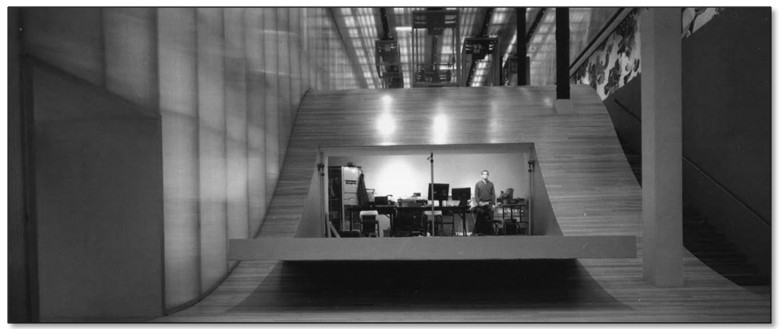 | Figure 8. Prada store, Soho, New York, designed by Rem Koolhaas (Huppatz, D.J, 2009) |
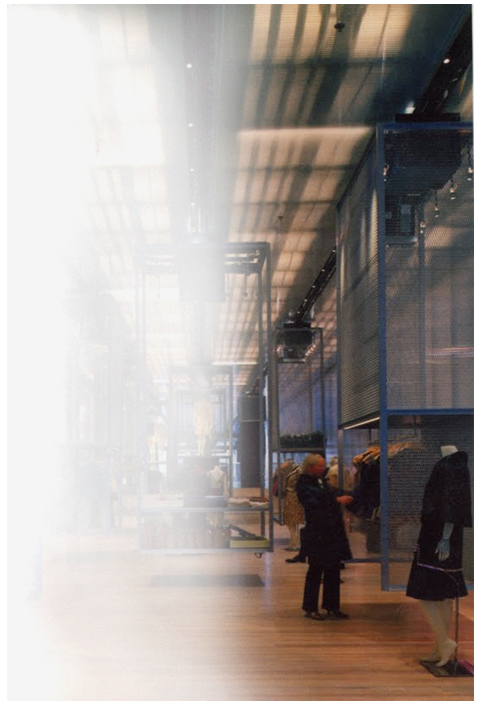 | Figure 9. Prada store, Soho, New York, designed by Rem Koolhaas (Cicognani, M & Landolfi, G) |
 | Figure 10. Prada store designed by Rem Koolhaas, Soho, New York (OMA) |
 | Figure 11. Prada store designed by Rem Koolhaas, Soho, New York (Huppatz, D.J, 2009) |
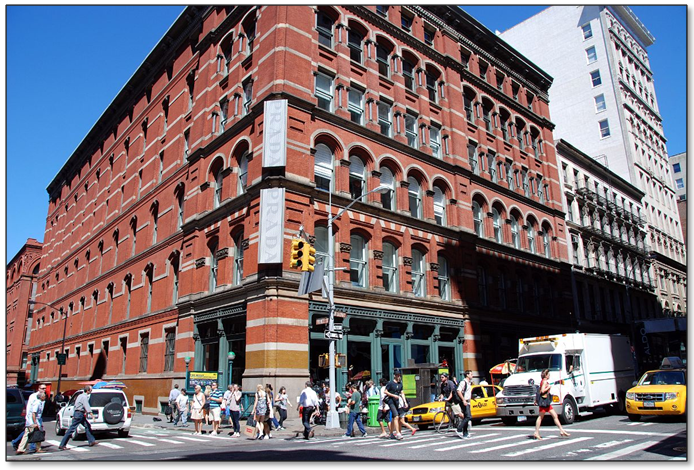 | Figure 12. Prada store designed by Rem Koolhaas, Soho, New York, Streetscape (ARTIS) |
8. Conclusions
- Within the realm of open public space, the appearances of storefronts play an improvement role in contributing to the character of cities, and the way humans identify with their surroundings. Also, shop front design is the major element to create an integrated decor, function and mode throughout a building facade. As previously mentioned, factors affecting the recognitions of store design and storefront designs and inferences on store characteristics through store designs are examined. I argued that there is a relationship between the recognitions of storefronts and responses on store characteristics. According to the results of analysis above, this study has demonstrated that, the design evaluation of storefronts is strongly related to the inferences about store characteristics in terms of the creativity, quality, fashion and the class of products which may be sold in that store. In other words, the study shows that positive evaluations of storefront design may lead to inferences that the store is high class, sells high quality and fashionable products. This study taught me that one of the major lessons was that the world was to be liberated through design philosophy, which is its prime promise in design in general and particularly a storefront design. One aspect of that liberation was the very real liberty to design by creativity. If there was to be a sense of liberation within this context, then the diversity or option was necessary to correlate: the liberty to choose. It was signified, specifically in design, that it was possible to make a pickup in lifestyle, or select pieces of a variety of lifestyles that suited one’s personality. Singularity was for everyone. With that came the liberty to define one’s opinions, ideology, religion or differently. Contrasts naturally arose with a diversity of interesting consequences. These liberties complete with their contradictions became support for designers, who freed themselves from dependency to conventional precedents: their designs was qualified by adopting freely from superficial signs of consumerism, sub-cultures and ‘ethnic’ sources, history and space-age futurism. But this was not the only lessons that I have learnt from this study. There are various factors affecting the evaluations of the storefronts and people tend to derive inferences about a store by looking at the design of the storefront. Some of these factors were mentioned more than others: novelty and creativity of the storefront compared to its competitors, theme used in the store display, allowing the shoppers to get information about the products, helped by coloring, lighting and type of materials. There is an obvious reason to planning these factors and this is because usually people tend to make associations with store characteristics through architectural designs, colors, materials and illumination used in the storefronts and also within the store and the theme in window displays. Generally, there is a difference between women and men about how they associate with these factors. In my opinion, women mostly able to give detailed descriptions on the storefronts which they liked while most of the men would like more functional reasons and hardly remembered the physical features of the storefront they liked. This may be related to different shopping habits of men and women because women enjoy shopping as a leisure activity and they are more likely to shop around, which means women become more curious and pay more attention to the store environment. However, the comparison between women and men is not a scientific estimation.This study has demonstrated that development and creativity in store design mostly make them significant with their different architectural features compared with other building around them. In fact, people remember the materials used in the facades, historical significance of the building which they belong to or the street which the store is located in like the Prada epicenter in Soho, New York that I argued previously.Finally, this study met the aims of this research via the case study of Prada epicenter. Mr Koolhaas created environments that always display the qualities of the surrounding space, which is a captured through feelings. Mr. Koolhaas has highlighted that through his creative design, he has established firmly a relationship; physical, visual, cultural, sensual, between shoppers and store design.
Figures
- • Figure 1, 4 & 8. Huppatz, D.J, 2009, Miuccia Prada/OMA/Rem Koolhaas: Prada Store, Viewed 11 January 2017. http://djhuppatz.blogspot.com.au/2009/08/muiccia-pradaomarem-koolhaas-prada.html• Figure 2. Betts, K 2007, Miuccia Prada, CREATIVE ICONS, Time. Viewed 23 March 2017. http://content.time.com/time/specials/2007/article/0,28804,1647860_1647834_1644300,00.html• Figure 3, Derotterdam, Rem Koolhaas, Viewed 23 February 2017. http://www.derotterdam.nl/en/vertical_city/rem_koolhaas• Figure 5, OMA, New York’s Prada Epicenter location, Viewed 9 June 2017. http://oma.eu/projects/prada-epicenter-new-york • Figure 6, New York’s Prada Epicenter location, Google Map, Viewed 9 June 2017. https://0x9.me/UPBfw • Figure 7, New York’s Prada Epicenter, Streetscape, Google Map, Viewed 9 June 2017. https://0x9.me/3XDIZ • Figure 9, Cicognani, M & Landolfi, G FASHION STORES, VOGUE, Viewed 25 November 2016. http://www.vogue.it/en/encyclo/architecture/s/fashion-stores• Figure 10 & 11, OMA, Prada Epicenter New York, Viewed 11 February 2017. http://oma.eu/projects/prada-epicenter-new-york • Figure 12, Prada Epicenter, Soho Downtown Manhattan, New York, Artis, Viewed 9 June 2017. http://www.artisnewyork.com/neighborhood/soho/
 Abstract
Abstract Reference
Reference Full-Text PDF
Full-Text PDF Full-text HTML
Full-text HTML